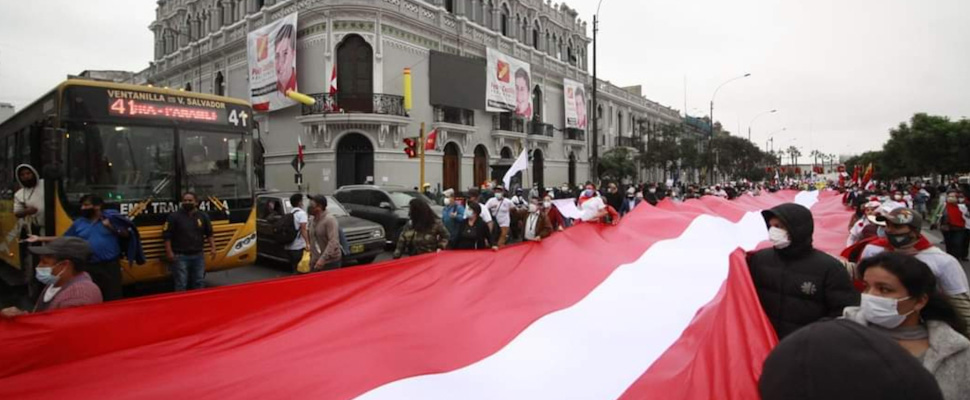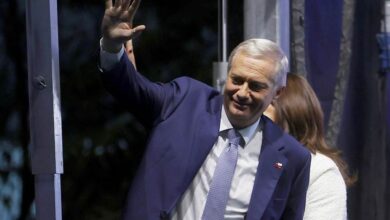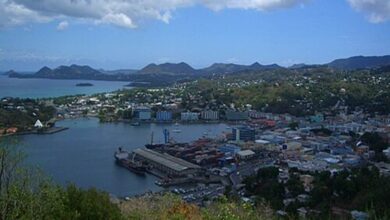The Inca country has experienced political instability for several years and the "new" national political landscape portends little governance.

All the last Peruvian presidents elected by popular vote are either investigated or convicted. Photo: TW-evoespueblo
LatinAmerican Post | Santiago Gómez Hernández
Listen to this article
Leer en español: Perú podrá tener nuevo presidente, pero seguirá en crisis
It seems that nations, in order to be considered Latino, must have, at the very least, political instability. Among the most marked examples of recent years is Peru. For almost 30 years it has lived in constant change and political crisis.
The political class in jail
All the last Peruvian presidents elected by popular vote are either investigated or convicted. From Alberto Fujimori and his crimes against humanity committed during his dictatorship (coming to power by popular vote), to Martín Vizcarra who was elected as vice president of PPK and dismissed by Congress last year.
Added to this list are Pedro Pablo Kuczynski himself (house arrest for money laundering), Alan García (accused of corruption and committed suicide before being arrested in 2019), Alejandro Toledo (extradition request), and Ollanta Humala (accused of have received USD 3 million for his campaign).
This has left Peru stupid in terms of political leaders. There is not a party that has governed and that later does not carry the burden of corruption. This allowed the overpopulation of parties and presidential candidates in the last elections, which ended up leaving Pedro Castillo and Keiko Fujimori in the second round.
The crisis continues
When it was expected that with these votes, stability and trust in the institutions and the political class would return, it seems that the opposite happened. After tight elections, there are more uncertainties and polarization than certainties.
¿Castillo o Fujimori? Renuncia de miembro clave en Jurado Nacional de Elecciones en Perú entrampa fin de proceso electoral https://t.co/jKlBBhkfnT pic.twitter.com/WFTvnVtDIo
— La Tercera (@latercera) June 25, 2021
The main reason is because of how close the elections were. With such a small margin and Fujimori's refusal to accept the results and ask for several ballots to be annulled, tension has gripped several regions of the country. Despite the fact that Fujimori's request is made under accusations of electoral fraud in several regions where her opponent won, the candidate has not presented any evidence to support that accusation. Several international organizations have even endorsed the electoral results.
Los seguidores de Keiko Fujimori y de Pedro Castillo salieron a las calles una vez más para respaldar los intereses de su candidato y reflejar la profunda división que se vive en el país. https://t.co/30jj2d095Z
— Univision Noticias (@UniNoticias) June 20, 2021
Faced with this tension, followers of both Keiko and Castillo have gathered in several cities in Peru. In the south, in the cities of Arequipa and Cusco, marches were held in support of the leader of the Peru Libre party. The marchers protest outside the offices of the electoral power to make Castillo's victory official. It is feared that the instability and uncertainty that today tarnishes Peru, could generate greater agglomerations, increase the health crisis due to the coronavirus and reduce investment. This is a demonstration that, whoever wins, will have half a country against them and that they may not recognize their victory.
Lack of Governance
But the problem would not end with the officialization of a winner: either Castillo (who is currently the virtual winner) or Fujimori. The close elections of two candidates with so much anti-vote is also an example of the polarization that Peru is experiencing. Anyone who remains as president will have a great challenge when governing.
#Elecciones2021. Congreso 2021-2026: 10 partidos tendrán representantes con Perú Libre y Fuerza Popular a la cabeza, según resultados de la ONPE al 91.424% de actas procesadas.
Lee la noticia completa: https://t.co/DYT9qoly01 pic.twitter.com/JbLfEOxeup
— SEMANAeconómica (@SEMANAeconomica) April 13, 2021
On the one hand, none of the parties that served as a platform for politicians has a majority of control of the legislature. This indicates that each bill that the executive wants to promote must form sufficient coalitions or obtain support from various movements.
Also read: How progressive or leftist is the possible new president of Peru?
And the previous presidency of the PPK-Martín Vizcarra duo demonstrated that if you do not have a coalition, it will be a headache and an impediment to pass the necessary reforms that Peru will face in a post-pandemic context.
Castillo begins to seek consensus
Being the main candidate to be proclaimed president, Castillo has already begun to make decisions or more conciliatory speeches and with the intention of lowering the fear of his considered extremist speech that he used in the campaign. One of his first announcements was to ratify the president of the Central Reserve Bank of Peru. In this way, it tries to send a message to the markets that this institution will maintain independence from the executive.
Peru’s leftist presidential candidate Pedro Castillo said he's willing to reappoint the head of the country’s central bank, his most market-friendly move yet https://t.co/1f4Jw29Sm4
— Bloomberg (@business) June 27, 2021
It only remains for them to put aside personal aspirations and give priority to seeking political and economic stability for the country.




